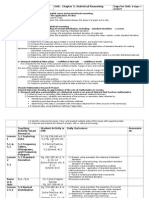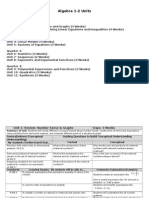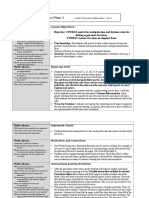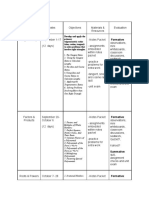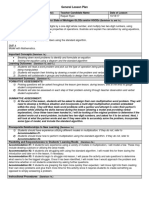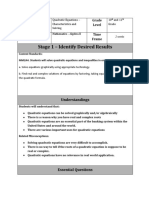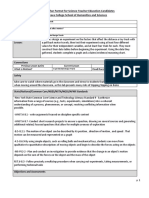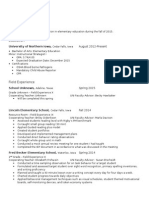0 ratings0% found this document useful (0 votes)
Chapter 6: Cognitive Theories of Learning
Uploaded by
api-406500886This summary provides the key details from the document in 3 sentences:
The document discusses chapters from an educational psychology textbook covering cognitive theories of learning, effective lesson design, constructivist approaches, and grouping strategies. It summarizes the main points about working memory and its role in learning, components of effective direct instruction lessons, Vygotsky's influence on constructivism, and differences between between-class and within-class ability grouping. The chapters examine how students learn and best instructional practices for supporting student learning and achievement.
Copyright:
© All Rights Reserved
Available Formats
Download as DOCX, PDF, TXT or read online from Scribd
Download as docx, pdf, or txt
Chapter 6: Cognitive Theories of Learning
Uploaded by
api-4065008860 ratings0% found this document useful (0 votes)
This summary provides the key details from the document in 3 sentences:
The document discusses chapters from an educational psychology textbook covering cognitive theories of learning, effective lesson design, constructivist approaches, and grouping strategies. It summarizes the main points about working memory and its role in learning, components of effective direct instruction lessons, Vygotsky's influence on constructivism, and differences between between-class and within-class ability grouping. The chapters examine how students learn and best instructional practices for supporting student learning and achievement.
Original Title
final
Copyright
© © All Rights Reserved
Available Formats
DOCX, PDF, TXT or read online from Scribd
Share this document
Did you find this document useful?
Is this content inappropriate?
This summary provides the key details from the document in 3 sentences:
The document discusses chapters from an educational psychology textbook covering cognitive theories of learning, effective lesson design, constructivist approaches, and grouping strategies. It summarizes the main points about working memory and its role in learning, components of effective direct instruction lessons, Vygotsky's influence on constructivism, and differences between between-class and within-class ability grouping. The chapters examine how students learn and best instructional practices for supporting student learning and achievement.
Copyright:
© All Rights Reserved
Available Formats
Download as DOCX, PDF, TXT or read online from Scribd
Download as docx, pdf, or txt
0 ratings0% found this document useful (0 votes)
Chapter 6: Cognitive Theories of Learning
Uploaded by
api-406500886This summary provides the key details from the document in 3 sentences:
The document discusses chapters from an educational psychology textbook covering cognitive theories of learning, effective lesson design, constructivist approaches, and grouping strategies. It summarizes the main points about working memory and its role in learning, components of effective direct instruction lessons, Vygotsky's influence on constructivism, and differences between between-class and within-class ability grouping. The chapters examine how students learn and best instructional practices for supporting student learning and achievement.
Copyright:
© All Rights Reserved
Available Formats
Download as DOCX, PDF, TXT or read online from Scribd
Download as docx, pdf, or txt
You are on page 1/ 7
Thomas Steele
Educational Psychology
Dr. Christine Hafer
Final Exam
Chapter 6: Cognitive Theories of Learning
1) Working memory is the second part of the memory system discussed by Slavin. Working
memory, also known as short term memory, is only capable of holding very small amounts of
information for relatively short periods of time. This period of time can be lengthened by things
like repetition (dubbed rehearsal in the Slavin text), which holds the information in the working
memory for a longer period of time. This small capacity means that information must be
processed to long term memory or sent to the proverbial recycling bin in chunks. A good
example of this is when I use a youtube video to learn a song on my guitar. I have to watch the
video in short chunks, pausing every few notes to mimic the hand positions of the person in the
video and play all of the song that I have learned so far. While the video itself goes through my
sensory register, remembering what I have seen and acting on it takes place in the working
memory. Playing back the song, each time adding the new part that I just learned, is the
rehearsal process. This makes it much more likely that I will remember how to play the song
later on, as it will hopefully be committed to my long term memory if I process it in my working
memory long enough. However, if I were to try and watch the video all the way through without
stopping, and then replicate what I had seen, it would be very difficult if the song had more than
just a few distinct notes or chords. Likely, all the steps in the song would be too much to process
or hold in working memory all at once, so I would probably only remember the most recent parts
I had watched, and a little bit of the beginning. This means that a major chunk of the necessary
knowledge is missing. Another good example of this would be playing the game Simon. The
colored lights would be input through sensory register, and working memory has only to hold
them long enough for you to repeat the pattern by pressing the corresponding buttons. Then the
pattern is given back to you with one new step added, so it’s held in the working memory by
repetition. This information is only needed for immediate reaction, so it does not go to long term
memory. However, as the game goes on, more and more iterations are added to the pattern,
and it becomes much more difficult to hold the pattern in working memory due to its small
capacity. Because the pattern is never committed to long term memory, you cannot pull
previous parts from anywhere but short term. Eventually you start losing parts of the pattern and
have to guess at what buttons to press. As can be seen in both these examples, working
memory simply cannot process large amounts of data at once. The best way to utilize working
memory in learning is to take things in small chunks, give them time to process, and use
rehearsal to store them to long term memory, then move on to the next chunk, processing the
lesson bit by bit. Trying to take on the entire thing at once can and likely will result in a
significant portion of information not being learned properly, or not being considered during a
decision. This is why we teach children the alphabet one letter at a time, or why we go step by
step when trying to solve a problem instead of jumping straight to a solution.
Chapter 7: The Effective Lesson
1) Slavin describes direct instruction as the transmission of information directly to students,
with lessons containing clearly defined learning goals. He states that the most effective direct
instruction lessons touch on any information or skills that might be required for the day’s lesson
(such as reviewing a previous lesson that ties into this one), inform students of what they will be
learning, teach the skills, gives the students opportunity to practice the skills, and then assess
the students on what they have learned and whether they have achieved the desired goals.
Take, for example, an English class in their Shakespeare unit. The teacher’s goal for the next
lesson is to teach the students about the sonnets, so he should follow these steps for direct
instruction. Each of these steps implements one or more of the required parts for effective direct
instruction as outlined in Slavin’s text:
1. State learning objectives and orient students to the lesson/ Review prerequisites:
Introduce the idea of the sonnets by leading a discussion of what they are. Then segue
into review of iambic pentameter with the students. This is the meter that the Bard wrote
his sonnets in. Since the students have previously learned about how it works, reviewing
the mechanics and pointing out how/where they appear in the example sonnet they just
read will help them begin to draw connections.
2. Introduce new material: Do a class read-through of one of the sonnets. Doing this
immediately after the review of iambic pentameter makes the mechanical connections
more obvious to the students, allowing them to see it in action.
3. Conduct learning probes/ Provide practice: Discuss with the students what they think are
important parts of the sonnets. This allows them time to process and construct ideas,
and gives the teacher some idea of how they are understanding the material. Instruct
them to take these ideas and attempt to write their own sonnet using the mechanics and
attributes discussed. They are now able to take the ideas they have formed and the
connections they suspect and test them out for themselves, which should help deepen
their understanding of the material.
4. Assess and provide feedback: Once students have finished their sonnets, assess each
on their use of the mechanics. This allows the teacher to see which students still need
more practice understanding the material. Provide feedback to each student on their
understanding, and help to correct any misunderstandings that may be relevant. This
gives the students time to process what is correct and adjust any concepts that they had
wrong, hopefully changing the concept wherever it is stored in long term memory.
5. Review the material: Assign homework to allow students a more guided practice now
that they have learned the basics and had any misconceptions pointed out to them. This
allows them to cement concepts and understanding, and will help to point out any further
misunderstandings they may still have.
Chapter 8: Student-Centered and Constructivist Approaches to Instruction
1) Slavin tells us that constructivism is based around the idea that in order to grow as
learners, students must piece together information of varying complexity to facilitate this growth
and development. Vygotsky’s influence over constructivism traces back to its roots, and can be
seen in four main concepts: social learning, the zone of proximal development, cognitive
apprenticeship, and mediated learning. Social learning is based around the idea that children
learn through interactions with others. During cooperative learning, children share their thought
processes with one another. This sharing exposes students to what successful problem solving
techniques look like, as they know what steps the most successful student is taking and can
mimic these steps later on. The zone of proximal development denotes anything that a student
is not capable of doing on their own, but can do with the assistance of their peers. Through this,
the students are still doing the work and undergoing discovery, albeit with help. This means that
later on they will grow and be able to do these tasks on their own, expanding their zone of
proximal development. Cognitive apprenticeship describes the ways in which a student
becomes an expert in something by working with a expert in that field. These experts are there
for to provide models and advice on how to complete a task, and to answer any questions the
students have. In this way, the students are building their content mastery through experience.
Finally, mediated learning is just another name for scaffolding. This is a form of guided learning
where students are initially given a task and the help they need to complete said task, but as
they grow in their mastery, they are given less and less help until they can accomplish it on their
own. All four of these ideas involve, in some way, students achieving goals and growing by
learning to complete various tasks through their own experience.
Chapter 9: Grouping, Differentiation, and Technology
4) From Slavin’s text, we can see that between class ability grouping is when students are
assigned to the “advanced” or “remedial” class in a subject based on their ability in that subject,
and within-class ability grouping is when students within a particular classroom are separated
into learning groups based on their perceived ability in a subject. Between class grouping is
typical seen in higher grade levels, around high school and sometimes middle school, while
within-class grouping is typically found at the elementary level. Between class grouping has
been shown to not be very effective towards improving student performance. There are slight
benefits to students who participate in more “advanced” level classes, but those that get stuck in
the low level ones receive few if any benefits. Researchers believe that this has to do with lack
of higher-achieving, “positive” role models for these low achieving students, and also a lack of
teacher interest in teaching remedial classes. Within-class grouping has been found to be more
effective, resulting in higher academic achievement for students. This is because it allows the
groups to be easily made and remade by the teacher as student ability develops, and also is
less stigmatizing to students than sending them to a whole new classroom based on their
abilities.
This tracking has cause issues primarily because it is usually heavily influenced by
standardized test scores. Due to the many problems with standardized tests that Slavin touches
on, such as reliability, validity, and the fact that test scores are not necessarily indicative of
student’s ability in a given subject, many people question whether or not tracking is helpful to
the students. It can also lock lower-achieving students into a track that they don’t want to be on,
such as steering them away from college and towards a vocational school. The tracking system
is not designed to help students “jump” tracks to better futures, but instead tends to lock
students into these achievement tracks. Low achieving students who should be helped and
challenged are instead given classes that do not challenge them and instead encourage low
performance, not giving them the opportunity to improve.
Chapter 10: Motivating Students to Learn
4) Slavin describes learned helplessness as “the perception that no matter what one does,
one is doomed to failure or ineffectuality,” (Slavin, p. 257). Essentially, it is the sense that you
are not as smart as the other students, or that you are downright stupid, and that this will cause
you to fail, so there is no point in putting forth effort since failure is inevitable. Slavin lists the
cause of learned helplessness as the incorrect use of the punishment/reward system by both
parents and teachers, which forces students to believe that there is little they can do to change
their perceived lack of intelligence. If expectations of students are unclear or too high, this can
exacerbate the problem. To alleviate this issue, educators can present the student with
“opportunities for success in small steps,” “immediate feedback,” and consistent expectations
and follow-through. An example of this would be asking the student singular questions, and
immediately praising them if they get the question correct or explaining the correct answer to
them if they get it wrong. It’s important to make sure that students see that they all have the
capacity for success and that none of them are beyond help, so giving them little victories and
letting them down gently when they answer incorrectly is imperative to reinforcing a more
positive image of themselves.
Chapter 11: Effective Learning Environments
1) Student centered classrooms are more focused around students dictating what the
standard for the classroom should be, according to Slavin. This means that the ways in which a
teacher would manage a classroom such as this would differ slightly from the traditional
classroom. Since these classrooms have a greater emphasis on students working together at
their own pace and leisure, although sets of rules should be put in place like in the normal
classroom, in the student-centered room the students should be allowed to dictate the rules that
most directly affect their learning, such as what time of day each subject is covered, whether or
not they get to pick partners for group work, what certain policies should be, etc. At the same
time, the teacher has to maintain control over the environment, so punishing disruptive students,
holding students to assigned deadlines, and expecting a standard of behavior (even if it is a
standard set by the students) are things that the teacher should maintain. This lets the students
know that even though this is about them, the teacher is still in control. Slavin also mentions that
although disciplinary standards should remain the same, expectations for student behavior
(such as expecting quiet during group work) should be changed to reflect the differing
environment. For example, in a traditional classroom, where much of the time is spent with the
teacher teaching and the learners listening, silence is reasonable to expect. Switching to a more
group-oriented learning environment, however, means that a certain level of noise should be
expected, and so instead of expecting silence, the teacher should talk with the students about
setting an acceptable noise level in the room and holding them to that.
Chapter 12: Learners With Exceptionalities
2) According to Slavin, a disability is any factor inherent to an individual that limits that
individual’s physical or mental capabilities, but a handicap is a factor that is introduced by
society, the environment, or even the person’s attitude upon an individual with a disability. Lack
of an available non-smoking area in an establishment for someone with severe asthma, lack of
a quiet, calm place for a veteran with ptsd to retreat to in public, and lack of accommodation for
a blind person’s seeing eye dog are all examples of handicaps imposed upon people with
varying disabilities. Slavin recommends certain guidelines for referring to a person with
disabilities, such as putting the person first (“child with learning disability” not “learning-disabled
child”) and ensuring that the disability is not equal to the person; in other words, the disability
does not define the person. While many people probably agree with the statement “labels are
harmful and should be eliminated from schools,” I tend to lean towards the side of
disagreement. While I do agree that some labels are unnecessary and hurtful (labeling people
by their sexual orientation isn’t necessary. We are all already individuals, and our sexual
orientation is encompassed in the uniqueness that makes up our individuality, so why not just
treat everyone as a human being?) labels relating to learning disabilities in the school
environment are certainly necessary. While it is entirely unnecessary and counterproductive to
refer to a student by their disability, having children labeled in some way (most likely within the
confines of a school file) ensures that the educators are aware that this student needs special
attention as compared to other students. Getting rid of labels completely not only denies
students with special needs the individualized attention they require, it underplays the disability
or may, in some cases, be akin to pretending the disability does not exist, which could be very
detrimental to the student’s well-being. I personally believe that Slavin gets it right when he
dictates guidelines for this labeling, instead of advocating that we not use labels in the first
place.
Chapter 13: Assessing Student Learning
2) Bloom’s taxonomy is a system of classification for educational objectives. Within this
taxonomy, there are six ascending levels as listed in Slavin’s text: knowledge (recalling
information), comprehension (translating, interpreting, or extrapolating information), application
(using principles or abstractions to solve a problem), analysis (breaking down complex
information or ideas into simpler parts to understand how the parts relate or are organized),
synthesis (creation of something that did not exist before), and evaluation (judging something
against a given standard).
a) “Students will critique a piece of artwork” - The highest level that this activity
represents is level six (evaluation). Critiquing a piece of artwork is definitely in
line with the idea of judging something against a given standard, as the student is
judging the piece of art based on what they think good art is. However, this also
represents analysis ( the student has to study the piece of art carefully, breaking
it down piece by piece to make their judgement), comprehension (the student
must understand both their objective and be able to interpret the piece of art),
and knowledge (the student must have some preconceived notion of what they
think makes “good” art).
b) “Using a map of the United States, students will label all state capitals” - The
highest level this represents is application. The students are using both their
previous knowledge and their understanding of the provided math to label the
cities in the correct place.
c) “Given a calculator, students will compute the area of rectangles” - The highest
level of the taxonomy represented here is application. The students are not
comparing the rectangles against anything else, nor are they creating a new
mathematical rule, they are simply solving a problem using their given knowledge
and understanding of the subject.
You might also like
- Graphic Organizer - Adding Subtracting and Multiplying PolyNo ratings yetGraphic Organizer - Adding Subtracting and Multiplying Poly1 page
- Task 4 - Part B - Mathematics Learning Segment Overview50% (2)Task 4 - Part B - Mathematics Learning Segment Overview3 pages
- Quadratics Lesson 4 Solving A Quadratic Equation by FactoringNo ratings yetQuadratics Lesson 4 Solving A Quadratic Equation by Factoring3 pages
- Mathematics: Analysis & Approaches: Unit QuestionNo ratings yetMathematics: Analysis & Approaches: Unit Question4 pages
- Unit Outline: MA5.2-1WM MA5.2-3WM MA5.2-15SP MALS-35SP MALS-36SP MALS-37SP100% (1)Unit Outline: MA5.2-1WM MA5.2-3WM MA5.2-15SP MALS-35SP MALS-36SP MALS-37SP37 pages
- MYP Unit Planner: Stage 1 - Establishing The Purpose of The UnitNo ratings yetMYP Unit Planner: Stage 1 - Establishing The Purpose of The Unit7 pages
- IB SL AA Unit 13 Modelling Change More CalculusNo ratings yetIB SL AA Unit 13 Modelling Change More Calculus7 pages
- Unit Question: Essential Questions: Learning ObjectivesNo ratings yetUnit Question: Essential Questions: Learning Objectives4 pages
- IDU Music Theory & Mathematics Formative Assessment 1 Grade 6No ratings yetIDU Music Theory & Mathematics Formative Assessment 1 Grade 63 pages
- Mathematics: Applications & Interpretations: Unit QuestionNo ratings yetMathematics: Applications & Interpretations: Unit Question3 pages
- Pearson - MYP Maths - Unit Plan - Sample - Y1 Ch7No ratings yetPearson - MYP Maths - Unit Plan - Sample - Y1 Ch76 pages
- Understanding Number System: Week 2 - Grade 6No ratings yetUnderstanding Number System: Week 2 - Grade 627 pages
- Helen Uttarotai Mini Unit Parallel & Perpendicular LinesNo ratings yetHelen Uttarotai Mini Unit Parallel & Perpendicular Lines26 pages
- Modelling Relationship: Mathematics: Analysis & ApproachesNo ratings yetModelling Relationship: Mathematics: Analysis & Approaches4 pages
- Course Overviews MYP Mathematics, UWC Thailand 2022-2023: Processes SolutionsNo ratings yetCourse Overviews MYP Mathematics, UWC Thailand 2022-2023: Processes Solutions9 pages
- I - S and Maths Grade 7 IDU Unit PlannerNo ratings yetI - S and Maths Grade 7 IDU Unit Planner9 pages
- Ib Mathematics HL/SL Exploration Marking Criteria: A: CommunicationNo ratings yetIb Mathematics HL/SL Exploration Marking Criteria: A: Communication3 pages
- IB HL AA Unit 07 Exponentials and IntegrationNo ratings yetIB HL AA Unit 07 Exponentials and Integration6 pages
- MYP 3 Unit Planner - Exponential FunctionsNo ratings yetMYP 3 Unit Planner - Exponential Functions4 pages
- IB SL AA Unit 08 - Quantifying RandomnessNo ratings yetIB SL AA Unit 08 - Quantifying Randomness4 pages
- Mathematics: Analysis & Approaches: Unit Question100% (2)Mathematics: Analysis & Approaches: Unit Question4 pages
- Underlying Principles and Strategies - Week2No ratings yetUnderlying Principles and Strategies - Week29 pages
- Lesson Plan Format For Science Teacher Education Candidates Ithaca College School of Humanities and SciencesNo ratings yetLesson Plan Format For Science Teacher Education Candidates Ithaca College School of Humanities and Sciences6 pages
- Lesson Plan 13: Previous Lesson (Unit) Current Lesson Next Lesson (Unit)No ratings yetLesson Plan 13: Previous Lesson (Unit) Current Lesson Next Lesson (Unit)3 pages
- Lesson Plan Format For Science Teacher Education Candidates Ithaca College School of Humanities and SciencesNo ratings yetLesson Plan Format For Science Teacher Education Candidates Ithaca College School of Humanities and Sciences11 pages
- School Punta Integrated School Grade Level Grade 9 Teacher Learning AreaNo ratings yetSchool Punta Integrated School Grade Level Grade 9 Teacher Learning Area2 pages
- A Detailed Lesson Plan in Principles of Teaching 2100% (1)A Detailed Lesson Plan in Principles of Teaching 27 pages
- Profed 11 - Curriculum Development and Evaluation: Technological University of The Philippines at CaviteNo ratings yetProfed 11 - Curriculum Development and Evaluation: Technological University of The Philippines at Cavite10 pages
- Session 1 Session 2 Session 3 Session 4: I. ObjectivesNo ratings yetSession 1 Session 2 Session 3 Session 4: I. Objectives3 pages
- The Teaching of Science Through The Performing Arts: Procedia - Social and Behavioral SciencesNo ratings yetThe Teaching of Science Through The Performing Arts: Procedia - Social and Behavioral Sciences3 pages
- Fractions, Decimals, and Rational NumbersNo ratings yetFractions, Decimals, and Rational Numbers43 pages
- Graphic Organizer - Adding Subtracting and Multiplying PolyGraphic Organizer - Adding Subtracting and Multiplying Poly
- Task 4 - Part B - Mathematics Learning Segment OverviewTask 4 - Part B - Mathematics Learning Segment Overview
- Quadratics Lesson 4 Solving A Quadratic Equation by FactoringQuadratics Lesson 4 Solving A Quadratic Equation by Factoring
- Unit Outline: MA5.2-1WM MA5.2-3WM MA5.2-15SP MALS-35SP MALS-36SP MALS-37SPUnit Outline: MA5.2-1WM MA5.2-3WM MA5.2-15SP MALS-35SP MALS-36SP MALS-37SP
- MYP Unit Planner: Stage 1 - Establishing The Purpose of The UnitMYP Unit Planner: Stage 1 - Establishing The Purpose of The Unit
- Unit Question: Essential Questions: Learning ObjectivesUnit Question: Essential Questions: Learning Objectives
- IDU Music Theory & Mathematics Formative Assessment 1 Grade 6IDU Music Theory & Mathematics Formative Assessment 1 Grade 6
- Mathematics: Applications & Interpretations: Unit QuestionMathematics: Applications & Interpretations: Unit Question
- Helen Uttarotai Mini Unit Parallel & Perpendicular LinesHelen Uttarotai Mini Unit Parallel & Perpendicular Lines
- Modelling Relationship: Mathematics: Analysis & ApproachesModelling Relationship: Mathematics: Analysis & Approaches
- Course Overviews MYP Mathematics, UWC Thailand 2022-2023: Processes SolutionsCourse Overviews MYP Mathematics, UWC Thailand 2022-2023: Processes Solutions
- Ib Mathematics HL/SL Exploration Marking Criteria: A: CommunicationIb Mathematics HL/SL Exploration Marking Criteria: A: Communication
- Lesson Plan Format For Science Teacher Education Candidates Ithaca College School of Humanities and SciencesLesson Plan Format For Science Teacher Education Candidates Ithaca College School of Humanities and Sciences
- Lesson Plan 13: Previous Lesson (Unit) Current Lesson Next Lesson (Unit)Lesson Plan 13: Previous Lesson (Unit) Current Lesson Next Lesson (Unit)
- Lesson Plan Format For Science Teacher Education Candidates Ithaca College School of Humanities and SciencesLesson Plan Format For Science Teacher Education Candidates Ithaca College School of Humanities and Sciences
- School Punta Integrated School Grade Level Grade 9 Teacher Learning AreaSchool Punta Integrated School Grade Level Grade 9 Teacher Learning Area
- A Detailed Lesson Plan in Principles of Teaching 2A Detailed Lesson Plan in Principles of Teaching 2
- Profed 11 - Curriculum Development and Evaluation: Technological University of The Philippines at CaviteProfed 11 - Curriculum Development and Evaluation: Technological University of The Philippines at Cavite
- Session 1 Session 2 Session 3 Session 4: I. ObjectivesSession 1 Session 2 Session 3 Session 4: I. Objectives
- The Teaching of Science Through The Performing Arts: Procedia - Social and Behavioral SciencesThe Teaching of Science Through The Performing Arts: Procedia - Social and Behavioral Sciences








